News from Borneo: Vol. 3
In the Malaysian state of Sabah of the island of Borneo, where the activities of the ITOCHU Group Forest for Orangutans take place, fourteen Company employees and employees of Group companies participated in a tree-planting tour in November 2011.
We introduce here the fascinating natural environment the participants encountered and their thoughts about the tour.

North Ulu Segama

This is the reforestation area for this project. We are supporting 967 hectares (approx. 207 times the size of the Tokyo Dome) for forest regeneration. By the end of September 2011, approximately 424.19 hectares (approx. 44%) of forest had been planted.
Comments from participants
On the journey to the reforestation area, plantations for the palm oil industry extended endlessly all the way to the entrance to the managed area, and even the managed area for reforestation was second and third generation forest where raw wood had been logged and left unattended. We cannot use the pretext of forest protection to apply unilateral pressure on the industry that has brought economic growth to Malaysia, but I felt that we could perhaps propose different methods of protection. It takes a long time to regenerate a forest, but the shortest way is precisely when more people empathize with these feelings. I hope that these tours will continue and that more people will feel empathy.
Comments from participants
I was a little doubtful about how to go about tree-planting. I imagined that we would dig the holes ourselves, but in fact the local WWF staff dug the holes for us ahead of time, and we only had to plant the saplings that were ready for us. However, planting the trees on slopes where the foothold was bad after the rain, and crouching in very little space to tamp down the clay-like soil was certainly not easy work. It took me 45 minutes to plant eight trees. As I planted, I wished for each of the trees to grow large and give food to the orangutans. Perhaps as a token of gratitude for my wish, on the way back, we had an encounter with a family of wild orangutans.
Sukau

This is a popular location for cruises on the Kinabatangan River, and a place where you can come across many wild animals such as crocodiles and proboscis monkeys.
Comments from participants
We were lucky to have encounters with a family of wild orangutans and the adorable Borneo’s pygmy elephants. On Borneo, there are a lot of animals and plants that we cannot see in Japan, birdcalls I have never heard before, and an abundance of insect sounds, and I had a strong impression of a place that is actually rich in biodiversity. To have been able to share in activities to protect this rich natural environment together with the other participants is a precious memory.
Sandakan

Sandakan is the second city after Kota Kinabalu. It flourished as trading post and as the heart of British North Borneo until 1947 when the capital was moved to Kota Kinabalu.
Comments from participants
With our own eyes, we saw water villages and other lifestyles you never see in Japan as we traveled by bus to a temple on a hill for the views over the beautiful ocean. There, we could see the scenery of old houses densely packed on the boundary between ocean and land. Looking into the distance, we saw nothing but the dark green of tangled jungle. Words are not adequate to describe the calm of that place.
Sepilok

The Orangutan Rehabilitation Centre, which returns orangutans on the verge of extinction to the wild, is located here.
Comments from participants
We visited the Rehabilitation Center where I learned that orangutans share 96.4 per cent of their DNA with human beings. Once again, I had a solid sense of how very similar and close orangutans are to human beings. However, orangutans do not have the power to regenerate the forests. The ITOCHU reforestation program is a very important activity to help with that, and once again I experienced the significance of the program. I look forward to the day when orangutans living in the wild will sleep and eat in the tops of the trees that we planted.
Kota Kinabalu

The gateway to tours of Borneo, Kota Kinabalu is a growing commercial center with a population of approximately 300,000. The tour starts from this city. WWF-Malaysia also has an office here.
Comments from participants
For the first time, I realized that tree-planting is not just about planting something in a place where there are few trees, but you have to consider the species of trees to plant, and calculate the ratios and spaces between them before planting. Also, if you don’t do a good job of covering the area around the roots with soil when you plant a tree, water will collect there and cause the roots to rot and wither. Even if the tree takes root safely, I learnt that it needs continued maintenance, and once again I became aware of the hard work of all the staff involved in this work, and that reforestation is not easy.
Tree-Planting Tour
Itinerary
Video of the tour
Reforestation Status as of December 2011
As of the middle of December 2011, 432.13 hectares (approx. 45%) of forest had been planted. At present, the remaining areas are in the process of reforestation, and the expectation is to have completed the tree-planting by the end of 2012. After that, maintenance work at the site will continue until July 2014, and from then on, the site will be left to grow naturally.
Tree-planting Report
Day 1 (November 3)
After a late night flight from Haneda, we arrived in Kota Kinabalu early in the morning. We visited a nearby bird sanctuary, and then at 9:00 a.m. we headed for the WWF-Malaysia office where we heard a lecture about forest protection techniques, its importance, current progress status, and methods for surveying the orangutans, followed by a lively question and answer session. After that, we transferred by propeller plane to Lahad Datu.




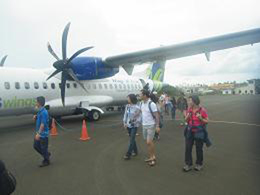
Day 2 (November 4)
Last night there was a tropical squall typical of the rain forest climate and we were worried about being able to do the tree-planting for the day. By the morning, the rain had more or less stopped, but everyone was looking a little tense until the last meeting at the hotel had finished, and we finally got underway. We left the town and passed through the palm tree plantations until we finally arrived at the tree-planting site.

leaving for the tree-planting site

At the reforestation site that ITOCHU supports, we were all able to verify the growth of the saplings planted by ITOCHU employees last year and the year before. This time, the area for planting was divided into five sections, and we planted 20 saplings in each section. Everyone worked hard on the steep slope to plant the saplings, one by one and eight meters apart, carefully covering them with soil.







in front of the signboard

an encounter with a wild orangutan
Growth Status of Planted Trees
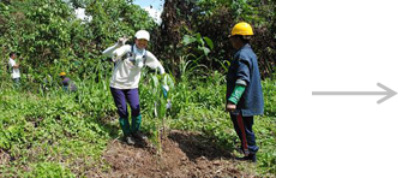

Day 3 (November 5)
Once the tree-planting was completed, we transferred by bus to Sukau where we stayed the night at a lodge along the Kinabatangan River. We went on a river cruise where we saw a lot of wild animals. (We had a warm welcome from orangutans, proboscis monkeys, pygmy elephants and lizards)



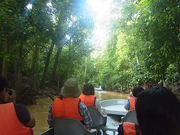



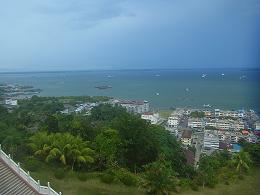
Day 4 (November 6)
After walking through a rainforest facility run by the Forestry Department of Malaysia in the morning, we visited the orangutan Rehabilitation Center at Sepilok for a video presentation and to watch the orangutans feeding.

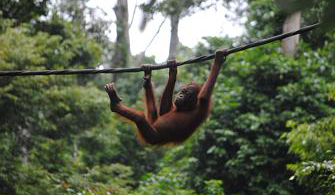

Corporates & Partners, Fundraising & Marketing Division, WWF Japan
A passion that performs miracles
The third tour has finished without any difficulties thanks to the participants as well as everyone involved at the office. Once again, I would like to thank you for your support. This year, I accompanied the tour and through exchanges with the participants, I was surprised at how everyone in the ITOCHU Group has a high level of awareness of wildlife protection and the preservation of the global environment, and as a participant I listened to the conversations with a great sense of appreciation. Despite being tired after traveling overnight, everyone listened enthusiastically when local WWF staff explained the project, and I was impressed by the numerous questions after the presentation. With the active attitudes of the employees of the ITOCHU Group, a leader in global business development, I felt confident that we were in good hands. On the night before tree-planting, there was a violent thunderstorm, and we worried about being able to do the tree planting, but perhaps because everyone’s enthusiasm was sky-high, we were blessed with good weather on the day, and were able to finish all the planned tree-planting work. In the hot and humid environment, planting even a few saplings was hard work, and it was really impressive to see how everyone maintained very serious expressions as they carefully planted one tree after another. We might even say that having the good fortune to see a mother and child orangutan appear at the tree-planting site was nature’s way of saying thank you, and perhaps a miracle that everyone performed together.






